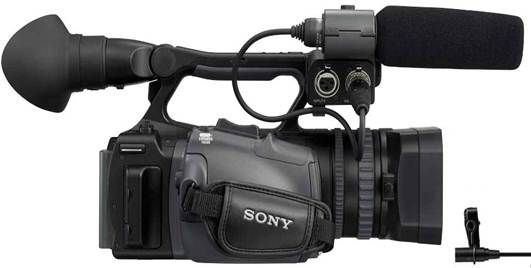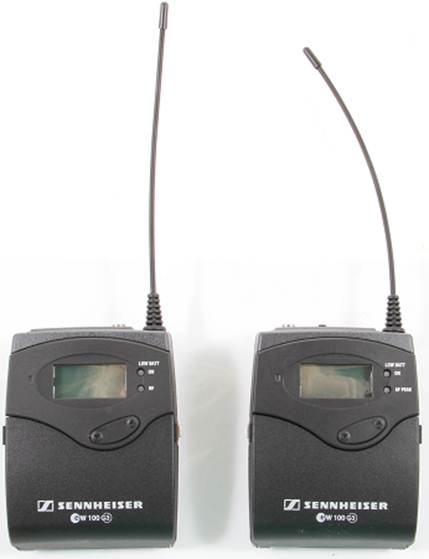Troubleshooting On Decent Quality Headphones
You wouldn’t ever film something without
being able to see what the camera is capturing, and audio is no different.
You should be plugged in whenever the
camera is rolling, and you should be using headphones that block out all
external sounds so you know you’re hearing exactly what the camera is hearing.
If you put your headphones on with the camera turned off and you can’t hear a
word the person standing next to you is saying, then you’ve got the right kind
of headphones. Sennheiser’s HD 25 are one such set of headphones, although
there are many equally capable cans out there.

Sennheiser’s
HD-25 are one such set of headphones, although there are many equally capable
cans out there.
Once you’re monitoring the sound, the next
most important thing is to have a backup. That means two audio sources going
into the camera. Conveniently, all cameras record in stereo, but you only need
mono, so that means you can record two different mics at the same time one on
left channel, the other on the right and then pick and choose which one you
want to use during the edit This usually boils down to either a handheld stick
mic or clip on Lavalier mic as one source, and a camera-mounted shotgun mic as
the second. This gives you a close-up source that records your subject and
separates them sufficiently from any background noise, and a fallback backup
you can tweak to bring out your subject’s voice if necessary.
Handheld or lay mics are often wireless,
which makes them easy to use on hectic shoots, as there’s one less wire to deal
with. The downside, especially with the number of camera crews you frequently
find at popular events, is interference. There’s only so much bandwidth
available for wireless trans missions, so if another crew is operating nearby
on the same band, you’re going to get interference. The only thing you can do
is change to a less-contested channel, but if the interference happens during
an actual interview, then chances are you’ll have to re-record if you have
time. If you don’t, then at least you have the wired shotgun mic to fall back
on.

If
you don’t, then at least you have the wired shotgun mic to fall back on.
One advantage of radio mics is that they’re
just that radio. In most setups, they’re only used to link one transmitter to a
single receiver, but you can go beyond that if you’re shooting with a
multi-camera setup. Radio mics are mostly used for a one-to-one connection, but
since it’s just transmit ting radio waves, there’s nothing stopping you picking
up the transmission on more than one receiver. On a two-camera shoot, then) you
might have your subject wearing a wireless lay mic and transmitter. The
receiver on your wide camera would then pick up the mic and record it along
with the video. The second, close-up camera would just use its on board mic,
which wouldn’t separate your subject from the background noise anywhere near as
well as the lay mic audio.
When It Comes to editing, you’d then need
to sync audio from the wide camera with the video from the close-up camera
before you could start producing the actual edit. This is fine if you’re
producing the video days or weeks later, but less ideal if you’re trying to
turn the videos around in minutes rather than hours to get them online as
quickly as possible. However, if you mount a second wireless receiver on the
close-up camera, tuned to the same frequency as the transmitter, you can record
exactly the same sound as the wide camera. Provided there aren’t any
interference problems during recording, there’s no need to sync the audio
before you start editing.
This receiver trick also works when you’re
recording a speaker presenting at an event. Ideally, you’ll get an audio feed
directly from the sound desk to pipe into one camera, which will give you the
best quality audio. However, you’re trusting that the crew operating the sound
desk know what they’re doing, which isn’t always the case. If they make a
mistake and there are audio dropouts, you won’t be able to use their feed.
Sometimes they can’t provide you with a sound feed, but if you can find out what
frequency they’re using for their wireless mic, you can tune in your receiver
and record the audio directly.

Sennheiser
EW 112-p G3
There are a few wireless mic systems on the
market, but the most popular is Sennheiser’s ewloo series. One advantage of it
being the most widely used is that it’s better at dealing with inference from
other units being used nearby, and also it increases the chances that any venue
you visit will also be using the same system, making it easy for you to tune
into the same frequencies if necessary.
So far, I’ve just looked at sound; I’ll be
covering filming in a future column. The main thing is to have options no two
shoots are ever the same and what works in one situation won’t necessarily work
in another. The more ways you have of achieving the result you want, the better
your chances of finding a solution quickly when you’re on location and hit a
snag. This gives you more time with your subject and increases the chances of
creating an amazing final product.